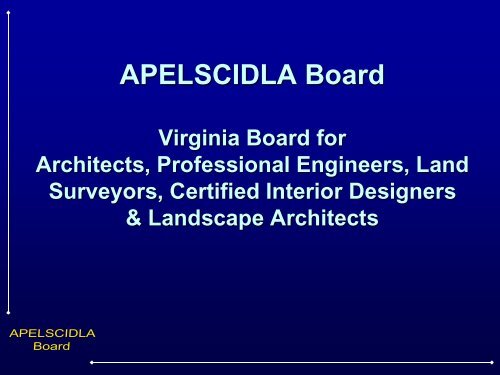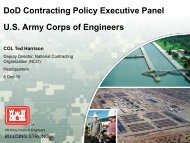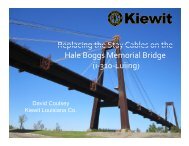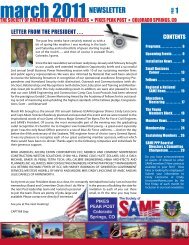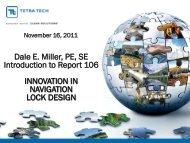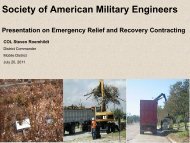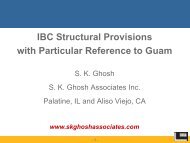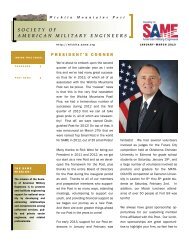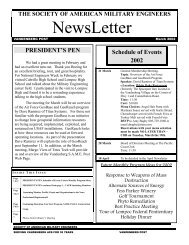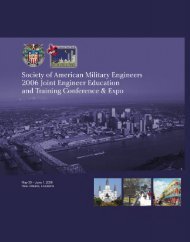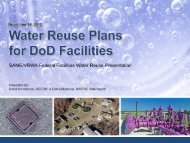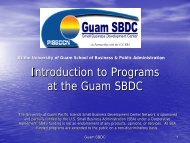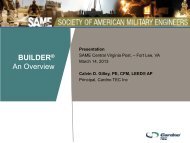APELSCIDLA Board
APELSCIDLA Board
APELSCIDLA Board
You also want an ePaper? Increase the reach of your titles
YUMPU automatically turns print PDFs into web optimized ePapers that Google loves.
<strong>APELSCIDLA</strong> <strong>Board</strong><br />
Virginia <strong>Board</strong> for<br />
Architects, Professional Engineers, Land<br />
Surveyors, Certified Interior Designers<br />
& Landscape Architects
Overview of the <strong>Board</strong><br />
• History of the <strong>Board</strong><br />
• <strong>Board</strong> Members<br />
• <strong>Board</strong> Staff
History of the <strong>Board</strong><br />
The APELS <strong>Board</strong> was created in 1920.<br />
Landscape Architects joined in 1980<br />
and Interior Designers joined in 1990 –<br />
creating the acronym “<strong>APELSCIDLA</strong>”!
The <strong>APELSCIDLA</strong> <strong>Board</strong><br />
Thirteen member <strong>Board</strong><br />
Examines, licenses, certifies and regulates<br />
Approximately 36,000 Architects,<br />
Professional Engineers, Land Surveyors,<br />
Certified Landscape Architects and<br />
Certified Interior Designers and related<br />
businesses in Virginia
<strong>Board</strong> Members<br />
(§ 54.1- 403 of the Code of Virginia)<br />
Architects<br />
• James R. Boyd<br />
• J. Everette “Ebo” Fauber, III<br />
(Chair)<br />
• Michael F. LeMay<br />
Professional Engineers<br />
• John L. Combs<br />
• Nico De Léon<br />
• Wiley V. “Bif” Johnson, III
Land Surveyors<br />
• Paul deC. Holt, Jr.<br />
• Nancy E. McIntyre<br />
• W. R. Stephenson, Jr.<br />
<strong>Board</strong> Members<br />
(§ 54.1- 403 of the Code of Virginia)<br />
Landscape Architects<br />
• Vaughn B. Rinner (Vice Chair)<br />
• Andrew M. Scherzer<br />
Certified Interior Designers<br />
• Lorri Finn<br />
• Cameron C. Stiles
<strong>Board</strong> Staff<br />
• Kate Nosbisch, Executive Director<br />
• Marian Brooks, <strong>Board</strong> Administrator<br />
• Justin Garofalo, <strong>Board</strong> Administrator<br />
• Amy Goobic, Administrative Assistant<br />
LICENSING SPECIALISTS :<br />
• Tonia Burrell<br />
• Joan Leonard<br />
• Ramona Norris<br />
• Toni Spencer<br />
• Patty Cordero
<strong>APELSCIDLA</strong> Regulant Counts<br />
as of April 1, 2011<br />
• Architects - 6,910<br />
• Professional Engineers – 26,156<br />
• Land Surveyors – 1,618<br />
• Interior Designers – 487<br />
• Landscape Architects – 823<br />
• <strong>APELSCIDLA</strong> Businesses – 3,366
<strong>Board</strong>’s Website<br />
The <strong>Board</strong>’s web-site contains the following:<br />
• Statutes and regulations<br />
• Contact information<br />
• <strong>Board</strong> meeting dates, agendas, and<br />
meeting minutes<br />
• Pending regulatory actions<br />
• Applications and newsletters<br />
• Exam information<br />
www.dpor.virginia.gov
Navigating the Website
Navigating the Website (cont.)
Navigating the Website (cont.)
Navigating the Website (cont.)
Navigating the Website (cont.)
Navigating the Website (cont.)
Overview of Licensing<br />
• Levels of Regulation<br />
• Definitions<br />
• Exemptions<br />
• Use of Seal<br />
• Disciplinary Actions
Levels of Regulation<br />
Levels of regulation pursuant to §§<br />
54.1-300 and 311 of the Code of<br />
Virginia:<br />
• Licensure (aka Practice Act);<br />
• Certification (aka Title Act); and<br />
• Registration (no attestation as to<br />
minimal competency)
Definitions<br />
Architect:<br />
"Architect" means a person who, by reason of his knowledge<br />
of the mathematical and physical sciences, and the principles<br />
of architecture and architectural design, acquired by<br />
professional education, practical experience, or both, is<br />
qualified to engage in the practice of architecture and whose<br />
competence has been attested by the <strong>Board</strong> through licensure<br />
as an architect.<br />
Professional Engineer:<br />
"Professional engineer" means a person who is qualified to<br />
practice engineering by reason of his special knowledge and<br />
use of mathematical, physical and engineering sciences and<br />
the principles and methods of engineering analysis and design<br />
acquired by engineering education and experience, and whose<br />
competence has been attested by the <strong>Board</strong> through licensure<br />
as a professional engineer.<br />
§ 54.1-400 of the Code of Virginia
Definitions<br />
Land Surveyor:<br />
"Land surveyor" means a person who, by reason of his<br />
knowledge of the several sciences and of the principles of land<br />
surveying, and of the planning and design of land<br />
developments acquired by practical experience and formal<br />
education, is qualified to engage in the practice of land<br />
surveying, and whose competence has been attested by the<br />
<strong>Board</strong> through licensure as a land surveyor.<br />
(See § 54.1-408 for Land Surveyor B)<br />
Certified Interior Designer:<br />
"Certified interior designer" means a design professional who<br />
meets the criteria of education, experience, and testing in the<br />
rendering of interior design services established by the <strong>Board</strong><br />
through certification as an interior designer.<br />
§ 54.1-400 of the Code of Virginia
Definitions<br />
Landscape Architect:<br />
"Landscape architect" means a person who, by reason<br />
of his special knowledge of natural, physical and<br />
mathematical sciences, and the principles and<br />
methodology of landscape architecture and landscape<br />
architectural design acquired by professional<br />
education, practical experience, or both, is qualified to<br />
engage in the practice of landscape architecture and<br />
whose competence has been attested by the <strong>Board</strong><br />
through licensure as a landscape architect.<br />
§ 54.1-400 of the Code of Virginia
Architecture<br />
The "practice of architecture" means any service<br />
wherein the principles and methods of architecture<br />
are applied, such as consultation, investigation,<br />
evaluation, planning and design, and includes the<br />
responsible administration of construction<br />
contracts, in connection with any private or public<br />
buildings, structures or projects, or the related<br />
equipment or accessories.<br />
§ 54.1-400 of the Code of Virginia
Engineering<br />
The "practice of engineering" means any service wherein the principles<br />
and methods of engineering are applied to, but are not necessarily<br />
limited to, the following areas: consultation, investigation, evaluation,<br />
planning and design of public or private utilities, structures, machines,<br />
equipment, processes, transportation systems and work systems,<br />
including responsible administration of construction contracts. The<br />
term “practice of engineering” shall not include the service or<br />
maintenance of existing electrical or mechanical systems.<br />
§ 54.1-400 of the Code of Virginia
Land Surveying<br />
The "practice of land surveying" includes surveying of areas for a<br />
determination or correction, a description, the establishment or<br />
reestablishment of internal and external land boundaries, or the<br />
determination of topography, contours or location of physical<br />
improvements, and also includes the planning of land and subdivisions<br />
thereof. The term "planning of land and subdivisions thereof" shall<br />
include, but not be limited to, the preparation of incidental plans and<br />
profiles for roads, streets and sidewalks, grading, drainage on the<br />
surface, culverts and erosion control measures, with reference to<br />
existing state or local standards.<br />
§ 54.1-400 of the Code of Virginia
Certified Interior Designer<br />
"Interior design" by a certified interior designer means any service<br />
rendered wherein the principles and methodology of interior design<br />
are applied in connection with the identification, research, and<br />
creative solution of problems pertaining to the function and quality<br />
of the interior environment. Such services relative to interior spaces<br />
shall include the preparation of documents for nonload-bearing<br />
interior construction, furnishings, fixtures, and equipment in order<br />
to enhance and protect the health, safety, and welfare of the public.<br />
§ 54.1-400 of the Code of Virginia
Landscape Architecture<br />
The "practice of landscape architecture" by a licensed landscape<br />
architect means any service wherein the principles and<br />
methodology of landscape architecture are applied in<br />
consultation, evaluation, planning (including the preparation<br />
and filing of sketches, drawings, plans and specifications) and<br />
responsible supervision or administration of contracts relative<br />
to projects principally directed at the functional and aesthetic<br />
use of land.<br />
§ 54.1-400 of the Code of Virginia
Renewal & Reinstatement<br />
• Renewals automatically mailed<br />
to address of record.<br />
• Reinstatement period is<br />
unlimited.<br />
• If a regulant reinstates, it is as if<br />
they never had a gap in<br />
licensure, certification or<br />
registration.
<strong>APELSCIDLA</strong> Exemptions…<br />
There are several exemptions contained in law :<br />
• § 54.1-401 exempts certain actions from<br />
licensure (also includes provisions for<br />
incidental work);<br />
• § 54.1-402 exempts certain individuals from<br />
licensure (however, if a regulant performs<br />
such work, they are required to sign and seal<br />
the work); and<br />
• § 54.1-402.1 exempts certain state and local<br />
government employees from licensure<br />
requirements under certain conditions (also<br />
see the provisions of § 54.1-406 D & E).
License Required…<br />
§ 54.1-406 License Required<br />
A. Unless exempted by § 54.1-401, 54.1-402, or 54.1-402.1, a<br />
person shall hold a valid license prior to engaging in the<br />
practice of architecture or engineering which includes design,<br />
consultation, evaluation or analysis and involves proposed or<br />
existing improvements to real property.<br />
B. Unless exempted by § 54.1-402, any person, partnership,<br />
corporation or other entity offering to practice architecture,<br />
engineering, or land surveying without being registered or<br />
licensed in accordance with the provisions of this chapter,<br />
shall be subject to the provisions of § 54.1-111 of this title.<br />
C. Any person, partnership, corporation or other entity which is<br />
not licensed or registered to practice in accordance with this<br />
chapter and which advertises or promotes through the use of<br />
the words "architecture," "engineering" or "land surveying" or<br />
any modification or derivative thereof in its name or<br />
description of its business activity in a manner that indicates<br />
or implies that it practices or offers to practice architecture,<br />
engineering or land surveying as defined in this chapter shall<br />
be subject to the provisions of § 54.1-111.
18VAC10-20-760 Use of Seal<br />
• The application of a professional seal<br />
indicates that the professional has<br />
exercised direct control and personal<br />
supervision over the work to which it is<br />
affixed.
Use of Seal (cont.)<br />
• If the original professional of record is no longer employed by the<br />
regulant or unable to seal the work, that work may be sealed by<br />
another professional, but only after a thorough review of the<br />
work to verify it has been accomplished to the same extent that<br />
would have been exercised if the work had been done under the<br />
direct control and personal supervision of the professional affixing<br />
the seal.
Disciplinary Actions<br />
Professional Engineers<br />
March 2006 – March 2011<br />
Violations Include:<br />
• Signed/sealed letter on letterhead of unlicensed<br />
engineering company with which he was not<br />
employed.<br />
• Submitted drawings that were unsealed,<br />
unsigned and undated.<br />
• Cheated on NCEES Engineers Exam - 2.<br />
• Utilized drawings of another engineer without<br />
written consent.
Disciplinary Actions (cont.)<br />
• Entered into an agreement; failed to complete<br />
the jobs required in the agreement.<br />
• Failed to notify the <strong>Board</strong> of license revocation in<br />
another state – 2.<br />
• Submitted plans not marked as “incomplete”,<br />
“advance” or “preliminary work.”<br />
• Failed to notify <strong>Board</strong> of disciplinary action in<br />
another state - 7.<br />
• Failed to include all relevant & pertinent<br />
information on sealed documents.
Disciplinary Actions (cont.)<br />
• Felony conviction resulting in revocation in<br />
another state.<br />
• Stamped plans prepared by unlicensed<br />
individual not under his direct control and<br />
personal supervision.<br />
• Placed seal on work of another regulant in<br />
another state without permission (also, did not<br />
date stamp plans, did not have direct control or<br />
personal supervision of the calculations he<br />
stamped and signed, implied by stamping and<br />
sealing plans that he had a business relationship<br />
where one did not exist).
Disciplinary Actions (cont.)<br />
• Signed and sealed drawings that were<br />
within the practice of architecture.<br />
• Submitted designs from own company to<br />
city for which licensee was a city official –<br />
conflict of interest.<br />
• Plead guilty and was convicted of<br />
conspiracy to violate the Foreign Corrupt<br />
Practices Act.
Disciplinary Actions (cont.)<br />
• Signed and sealed a survey that was not incidental to the<br />
engineering work. Failed to utilize minimum field procedures failed<br />
to correctly identify the title of the survey; include the district and the<br />
county in which the subject property was located in the title of the<br />
Surveys; identify the owner of the Western adjoining property;<br />
correctly indicate who the owner of the subject property was at the<br />
time the Surveys were performed; and include the distance to the<br />
nearest street intersection on the Surveys. The metes and bounds<br />
description of the Surveys used adjoining property designations that:<br />
were not included on the land surveys; followed the centerline of an<br />
easement rather than a boundary line; and failed to include pertinent<br />
monumentation or names of record owners. Misrepresented that<br />
certain items were included in the survey when, in fact, the items<br />
were not included.<br />
•
Disciplinary Actions<br />
Architects<br />
March 2006 – March 2011<br />
Violations Include:<br />
• Felony conviction – bribing an official.<br />
• Failure to inform client of association with a<br />
business.<br />
• Presented calculations to locality that he did not<br />
have permission to submit and was not truthful<br />
when he presented them, knowing that he did<br />
not have permission to use them.
Disciplinary Actions (cont.)<br />
• Failure to notify <strong>Board</strong> of action in another<br />
state – 5.<br />
• Specs not Architect’s own without written<br />
permission.<br />
• Sketches not marked “incomplete,”<br />
“advance” or “preliminary.”<br />
• Failure to sign, seal or identify plans as<br />
“incomplete,” “advance” or “preliminary.”
Disciplinary Actions (cont.)<br />
• Failed to sign pages of drawing which<br />
contained solely their work; failed to<br />
include name, address and project name<br />
on the drawings; and failed to ensure all<br />
regulated disciplines affixed a seal,<br />
original signatures and date.<br />
• Charged clients for time spent obtaining<br />
bid form contractor who was not properly<br />
licensed to perform proposed construction.
Disciplinary Actions<br />
Land Surveyors<br />
March 2006 – March 2011<br />
Violations Include:<br />
• Failure to notify <strong>Board</strong> of license suspension in another<br />
state.<br />
• Signed and sealed plat without properly completing<br />
boundary survey.<br />
• Failure to include all Deed Book references for adjoining<br />
owners on plat.<br />
• Failure to include the source of meridian on survey map<br />
and failure to include statement that map was based on<br />
a current field survey.
Disciplinary Actions (cont.)<br />
• Prepared a “line survey” and entitled the plat “boundary<br />
survey” when a current field survey had not been<br />
performed.<br />
• Failure to apply professional seal, signature or date to<br />
survey.<br />
• Prepared plat that did not meet standards set forth for<br />
land boundary surveys performed in the Commonwealth.<br />
• Failed to: conduct a proper search of land records, to<br />
monument a new corner, establish existing corners of<br />
property lines, and to perform computations to show that<br />
the standards for a land boundary survey located in a<br />
rural area were met in the survey.
Disciplinary Actions (cont.)<br />
• Survey did not contain closed traverse field notes and<br />
calculations showing closure of traverse and calculations<br />
to balance the traverse.<br />
• Survey did not contain set corners.<br />
• Failure to register corporation with the <strong>Board</strong>.<br />
• Failed to properly stake the corners and property<br />
boundaries which resulted in a well being built on a<br />
neighbor’s property.<br />
• Failed to disclose in writing that contracted survey work<br />
had been performed by another company.
Disciplinary Actions (cont.)<br />
• Misrepresented information about right-of-way,<br />
intentionally misled locality in order to have plat<br />
approved and recorded.<br />
• Improper wording used in “Owner’s Statement” as<br />
required by the Code of Virginia.<br />
• Plat did not contain evidence of a title report, also failure<br />
to set corners or show physical encroachment on<br />
property line.<br />
• Failed to date two final house location surveys.
Disciplinary Actions (cont.)<br />
• Prepared a plat improperly using a creek from an old<br />
survey as the boundary line; also failed to clearly identify<br />
on the plat, the inconsistency found in researching the<br />
common boundary between property line and the<br />
adjoining property; also submitted a survey that was not<br />
sealed, signed and dated or identified as advance,<br />
preliminary, or incomplete.
Disciplinary Actions (cont.)<br />
• Prepared a plat that failed to show the name of the owner of<br />
record and deed reference; width of the road; bearings of all<br />
property lines; source of meridian used; area to the square<br />
foot or thousandth of an acre; tax map or geographic parcel<br />
numbers; statement that the land boundary survey shown was<br />
based on a current field survey; a statement as to whether or<br />
not a current title report was furnished; and a statement as to<br />
whether any or all easements were shown.<br />
• Prepared a plat that failed to show the width of the road;<br />
bearings of all property lines; area to the square foot or<br />
thousandth of an acre; statement that the land boundary<br />
survey shown was based on a current field survey; a<br />
statement as to whether or not a current title report was<br />
furnished; and a statement as to whether any or all<br />
easements were shown.
Disciplinary Action (cont.)<br />
Landscape Architects<br />
December 2007<br />
• Licensee failed to disclose that he was paid by a<br />
construction company for providing consulting<br />
services during the course of construction on<br />
clients property.
Disciplinary Actions (cont.)<br />
Sanctions Included:<br />
• Fines ranging from $150 to $5,500<br />
• Required continuing education courses<br />
• Provide proof of compliance for disciplinary action in<br />
another state<br />
• Completion of course covering <strong>Board</strong> rules and<br />
regulations<br />
• Probation<br />
• Banned from PE Examination for a 4-year period<br />
• Suspension of license<br />
• Surrender of license<br />
• Revocation of license
Guidance Document<br />
Requirements for Topographic Surveys in Virginia<br />
Purpose<br />
The purpose of this document is to clarify 18VAC10-20-382.B.11 of the<br />
<strong>Board</strong>’s regulations, performance standards for conducting<br />
topographic surveys, and the use of unregulated topographic<br />
surveys.<br />
Statement Requirement for Surveys<br />
Currently, <strong>Board</strong> regulations require that a certification statement be<br />
included with all topographic surveys:
18VAC10-20-382.B.11<br />
Guidance Document cont.<br />
“A statement, in the following form, shall be shown on or contained in<br />
plats, maps, or digital geospatial data including metadata:<br />
This ________________ (provide description of the project) was<br />
completed under the direct and responsible charge of,<br />
_______________________________ (Name of Surveyor or<br />
Surveyor Photogrammetrist) from an actual Ground or Airborne<br />
(check the one that is applicable) survey made under my<br />
supervision; that the imagery and/or original data was obtained on<br />
______________ (Date); and that this plat, map, or digital<br />
geospatial data including metadata meets minimum accuracy<br />
standards unless otherwise noted.”
Guidance Document cont.<br />
The statement indicates that the “Name of Surveyor or Surveyor<br />
Photogrammetrist” is required. The individuals authorized to perform<br />
topographic surveys are land surveyors and surveyor<br />
photogrammetrists licensed pursuant to 54.1-400 (et seq.) of the<br />
Code of Virginia. However, licensed architects and professional<br />
engineers are also authorized by Virginia statute to perform<br />
topographic surveys provided the survey is incidental to the<br />
architectural or engineering project, respectively:<br />
§ 54.1-401. Exemptions.<br />
“The following shall be exempted from the provisions [surveyor license]<br />
of this chapter:<br />
1. Practice of professional engineering and land surveying by a<br />
licensed architect when such practice is incidental to what may be<br />
properly considered an architectural undertaking.
Guidance Document cont.<br />
2. Practice of architecture and land surveying by a licensed<br />
professional engineer when such practice is incidental to an<br />
engineering project.”<br />
It is the intent of the <strong>Board</strong>’s regulations that the statement<br />
required by 18VAC10-20-382.B.11 of the <strong>Board</strong>’s regulations<br />
be signed by whichever professional completed the survey-<br />
surveyor, surveyor photogrammetrist, architect, or<br />
professional engineer.
Survey Performance Standard<br />
Guidance Document cont.<br />
<strong>Board</strong> regulations also require that any licensed professional,<br />
authorized to perform a survey, must perform the survey to<br />
the standards contained in 18VAC10-20-382 of the <strong>Board</strong>’s<br />
regulations:<br />
18VAC10-20-730.C<br />
“The professional shall adhere to the minimum standards and<br />
requirements pertaining to the practice of his own profession,<br />
as well as other professions if incidental work is performed.”
Guidance Document cont.<br />
When a licensed surveyor or surveyor photogrammetrist performs a<br />
topographic survey, or if an architect or professional engineer<br />
performs a topographic survey incidental to an architectural or<br />
engineering project, respectively, he must seal, sign, and date the<br />
survey per <strong>Board</strong> regulations:<br />
18VAC10-20-382.A<br />
“The minimum standards and procedures set forth in this section are to<br />
be used for topographic surveys performed in the Commonwealth of<br />
Virginia pursuant to Chapter 4 (§ 54.1-400 et seq.) of Title 54.1 of<br />
the Code of Virginia. The application of the professional's seal,<br />
signature and date as required by these regulations shall be<br />
evidence that the topographic survey is correct to the best of the<br />
professional's knowledge and belief, and complies with the minimum<br />
standards and procedures.”
Guidance Document cont.<br />
<strong>Board</strong> regulations also require a seal, signature, and date even<br />
in situations where a license is not required:<br />
18VAC10-20-760.B.4<br />
“The seal of each professional responsible for each profession<br />
shall be used and shall be on each document that was<br />
prepared under the professional's direction and for which that<br />
professional is responsible. If one of the exemptions found in<br />
§ 54.1-402 of the Code of Virginia is applicable, a professional<br />
licensed or certified by this board shall nevertheless apply his<br />
seal to the exempt work.”
Guidance Document cont.<br />
Use of Unregulated Topographic Surveys<br />
The Code of Virginia requires that a topographic survey be performed<br />
by a professional who is duly licensed by the <strong>Board</strong>. Topographic<br />
surveys used in the design, modification, construction of<br />
improvements to real property, or for flood plain determination must<br />
be sealed, signed, and dated by the licensed professional who<br />
performed the survey or directly supervised the person who<br />
performed the survey. A topographic survey that is not sealed,<br />
signed, and dated by a professional must only be used for general<br />
information pursuant to Virginia statute:<br />
•
Guidance Document cont.<br />
§ 54.1-402.C Further exemptions from license requirements<br />
for architects, professional engineers, and land<br />
surveyors.<br />
(third paragraph) “Any person not licensed pursuant to<br />
subsection B of § 54.1-404 or 54.1-406 preparing<br />
documentation pursuant to subsection C of § 54.1-402 shall<br />
note the following on such documentation: "Any determination<br />
of topography or contours, or any depiction of physical<br />
improvements, property lines or boundaries is for general<br />
information only and shall not be used for the design,<br />
modification, or construction of improvements to real property<br />
or for flood plain determination."
Summary<br />
Guidance Document cont.<br />
The excerpts from Virginia statutes and <strong>Board</strong> regulations are<br />
provided above for your convenience to help you locate the<br />
text from the administrative and positive law that establishes<br />
the <strong>Board</strong>’s authority. To conclude the information above, the<br />
following summaries of this document are provided:<br />
1. Although the <strong>Board</strong>’s regulations indicate that the survey<br />
statement requires the “Name of Surveyor or Surveyor<br />
Photogrammetrist”, the architect or engineer who performed<br />
the survey, or directly supervised the individual who<br />
performed the survey, must place his name on the statement<br />
required by the regulations.
Guidance Document cont.<br />
2. Surveys must be performed to the standards established in the<br />
<strong>Board</strong>’s regulations whether the survey is performed by a licensed<br />
surveyor, surveyor photogrammetrist, architect, or professional<br />
engineer as indicated in this document. All surveys, regardless of<br />
whether exempt from statutory licensure requirements, must be<br />
sealed, signed, and dated by the professional who performed the<br />
survey or directly supervised the individual who performed the<br />
survey.<br />
3. Any professional licensed by the <strong>Board</strong>, who utilizes a topographic<br />
survey to perform professional work, must ensure that the survey is<br />
sealed, signed, and dated properly as indicated above.<br />
Professionals whose work includes the use of unregulated<br />
(unsealed, unsigned, and undated) topographic surveys are in<br />
violation of the <strong>Board</strong>’s regulations.
Update - Continuing Education<br />
WHO IS REQUIRED TO COMPLETE CE?<br />
• Architects<br />
• Professional Engineers<br />
• Land Surveyors<br />
• Landscape Architects<br />
Basically, all licensed professions under the<br />
<strong>APELSCIDLA</strong> <strong>Board</strong>.
Update - Continuing Education<br />
(cont.)<br />
• Section 54.1-404.2 of the Code of Virginia<br />
requires completion of the equivalent of 16<br />
hours per biennium of <strong>Board</strong> approved<br />
continuing education activities.<br />
• The regulations are drafted broadly to allow<br />
licensees the flexibility to meet continuing<br />
education requirements through a variety of<br />
methods as long as the coursework falls within<br />
the regulation 18VAC10-20-683.C.
Update - Continuing Education<br />
(cont.)<br />
Reg 18VAC10-20-683.C.1 – CE activities must:<br />
• Be related to the practice of the profession of the license<br />
being renewed.<br />
• Have a clear purpose and objective that will maintain,<br />
improve, or expand the skills and knowledge relevant to<br />
practice.<br />
NOTE: The regulations do not preclude<br />
acceptance of CE from other states or federal<br />
agencies, or for profit or non-profit sponsors, as long as the<br />
requirements of 18VAC10-20-683 are met.
Update - Continuing Education<br />
(cont.)<br />
• May be in areas related to business practices<br />
such as:<br />
- project management<br />
- risk management<br />
- ethics<br />
NOTE: CE credit hours are valid only during the two year<br />
period prior to license expiration date. There is no<br />
allowance for carry-over of CE credit hours.
Update - Continuing Education<br />
(cont.)<br />
• Curriculum must be consistent with the<br />
purpose and objective of the CE activity.<br />
• Sponsors must have sufficient resources<br />
to provide the CE activity and provide<br />
documentation of completion to those who<br />
successfully complete the CE activity.
Update - Continuing Education<br />
(cont.)<br />
• Instructors must be competent in the subject<br />
being taught, either by education or experience.<br />
• Fifty contact minutes shall equal one CE credit<br />
hour.<br />
• For segments less than fifty minutes, the sum of<br />
the segments may be totaled for computation of<br />
CE credit hours for that one CE course or<br />
activity.
Update - Continuing Education<br />
(cont.)<br />
• One semester credit hour of approved<br />
college credit equals 15 CE credit hours.<br />
• One quarter credit hour of approved<br />
college credit equals 10 CE credit hours.
Update - Continuing Education<br />
(cont.)<br />
• Self-directed activity must have an assessment by the<br />
sponsor at the conclusion to verify the individual has<br />
achieved the purpose and objective of the activity; credit<br />
will not be awarded if the individual has not passed the<br />
assessment.<br />
• CE credit will not be granted for serving as an officer in<br />
an association or serving on a committee.<br />
• CE credit will not be granted for community service,<br />
“Career Day”, or other lay presentations.<br />
• CE credit will not be granted for authoring papers or<br />
articles for magazines or journals.
Update - Continuing Education<br />
(cont.)<br />
• Licensee may be granted credit for the<br />
initial development or substantial updating<br />
of a CE activity.<br />
• Credit may be received for the initial<br />
teaching of a course that otherwise meets<br />
the requirements at twice the amount of<br />
credit that students of the course would<br />
receive.
Update - Continuing Education<br />
(cont.)<br />
• Additional credit for subsequent offerings<br />
of the course or activity with the same<br />
content will not be permitted.<br />
• Licensees will not receive credit for<br />
completing the same CE activity with the<br />
same content more than once during the<br />
license period immediately prior to the<br />
expiration date of the license for renewal.
Update - Continuing Education<br />
(cont.)<br />
• Licensees will not receive credit for completing the same<br />
CE activity with the same content during the two years<br />
immediately prior to the date of receipt by the <strong>Board</strong> of a<br />
reinstatement application.**<br />
• Only CE activities completed during the license period<br />
immediately prior to the expiration date of the license<br />
shall be acceptable in order to renew.<br />
NOTE: Submission of CE documentation is NOT required for<br />
renewal.
Update - Continuing Education<br />
(cont.)<br />
• CE activities utilized to satisfy the CE<br />
requirements to renew a license shall be valid<br />
only for that renewal.<br />
• Individuals shall maintain records of completion<br />
of CE activities that comply with the<br />
requirements for three years from the date of<br />
expiration of the license.<br />
• Individuals shall provide documentation of CE to<br />
the <strong>Board</strong> or its agents upon request.
Update - Continuing Education<br />
(cont.)<br />
• CE activities used to renew for a<br />
preceding license cycle shall not be<br />
accepted for subsequent renewal or<br />
reinstatement.<br />
• When applying for reinstatement,<br />
evidence of compliance with CE<br />
requirements shall be included with the<br />
reinstatement application package.
Update - Continuing Education<br />
(cont.)<br />
• CE activities submitted in support of<br />
reinstatement shall not be more than two years<br />
old as of the date a complete reinstatement<br />
application is received by the <strong>Board</strong>.<br />
• CE activities submitted for reinstatement shall<br />
only be valid for that reinstatement and shall not<br />
be applied towards subsequent renewals or<br />
reinstatements.
Update - Continuing Education<br />
(cont.)<br />
• The <strong>Board</strong> may conduct a random audit of<br />
licensees to determine CE compliance.<br />
• Licensees selected for audit shall provide<br />
documentation of all CE utilized to renew<br />
the license within 21 calendar days of<br />
receiving notification of audit.
Update - Continuing Education<br />
(cont.)<br />
18VAC10-20-687 Exemptions and Waivers<br />
• <strong>Board</strong> may grant exemptions or waive or reduce<br />
the number of CE activities required in cases of<br />
certified illness or undue hardship.<br />
• Such exemptions, waivers, or reductions shall<br />
not relieve the individual of their obligation to<br />
comply with other requirements of this chapter.
Update - Continuing Education<br />
(cont.)<br />
18VAC10-20-790 Sanctions<br />
• <strong>Board</strong> may discipline or sanction, or both,<br />
any license holder who fails to comply or<br />
misrepresents any information pertaining<br />
to CE requirements.
Update - Continuing Education<br />
(cont.)<br />
• There is no requirement that CE activities must take<br />
place in Virginia.<br />
• There is no requirement that CE activities be in a formal<br />
classroom setting.<br />
• There is no requirement specifically addressing what<br />
types of CE courses or activities must be completed.<br />
Licensees located not only in Virginia but<br />
worldwide have the flexibility to meet CE<br />
requirements in a variety of settings.
Update - Continuing Education<br />
(cont.)<br />
Continuing Education Regulation 18VAC10-<br />
20-683 went into effect April 1, 2009;<br />
there was a 12 month delayed enactment<br />
clause. Therefore CE is required for all<br />
licensees renewing or reinstating on or after<br />
April 1, 2010.
Update - Continuing Education<br />
(cont.)<br />
So how does this affect me?<br />
Example: If your license expires April 30, 2011, you<br />
must attest to 16 hours of CE earned between May<br />
1, 2009 and April 30, 2011.<br />
NOTE: You cannot attest to completion of<br />
CE requirements prior to actual completion.
Did You Know…<br />
• The <strong>Board</strong> now has an Emeritus status for<br />
licensees in good standing who are no longer<br />
practicing and do not wish to renew their license.<br />
• Emeritus professionals are not required to obtain<br />
CE.<br />
• If an Emeritus professional wishes to resume<br />
practice, he must reinstate his license to become<br />
active.<br />
• You cannot practice with an expired license.
Did You Know…<br />
• If you hold more than one license, you need 16 hours of CE per<br />
license.<br />
• If you hold more than one license and find a CE activity that would<br />
meet the requirements for both licenses, you could count it for both.<br />
However, be mindful the CE activity has to have occurred within the<br />
2 year window for each license.<br />
• CE requirements vary from state to state.<br />
• The <strong>Board</strong> has no control over what CE activities may be accepted<br />
by other states.<br />
• The <strong>Board</strong> is not pre-approving or providing CE activities due to the<br />
different professions and specialties within the professions.
Did You Know…<br />
• There is no CE exemption for licensees living outside of Virginia.<br />
• There is no CE exemption for “expert witnesses”.<br />
• There is no CE exemption for advanced degrees.<br />
• There is no CE exemption for small firms with nominal number of<br />
licensed individuals.<br />
• There is no CE exemption for age or years of practice.<br />
However, the licensee may request <strong>Board</strong> consideration of an<br />
exemption under “undue hardship” or “certified illness”.<br />
• The <strong>Board</strong> voted at its June 2010 meeting to waive CE requirements<br />
for active military serving overseas.
Contacting the <strong>Board</strong><br />
<strong>APELSCIDLA</strong> <strong>Board</strong><br />
Department of Professional &<br />
Occupational Regulation<br />
9960 Mayland Dr., Suite 400<br />
Richmond, VA 23233<br />
(804) 367-8506/8512<br />
www.dpor.virginia.gov<br />
apelscidla@dpor.virginia.gov
Questions, Comments, Thoughts…


